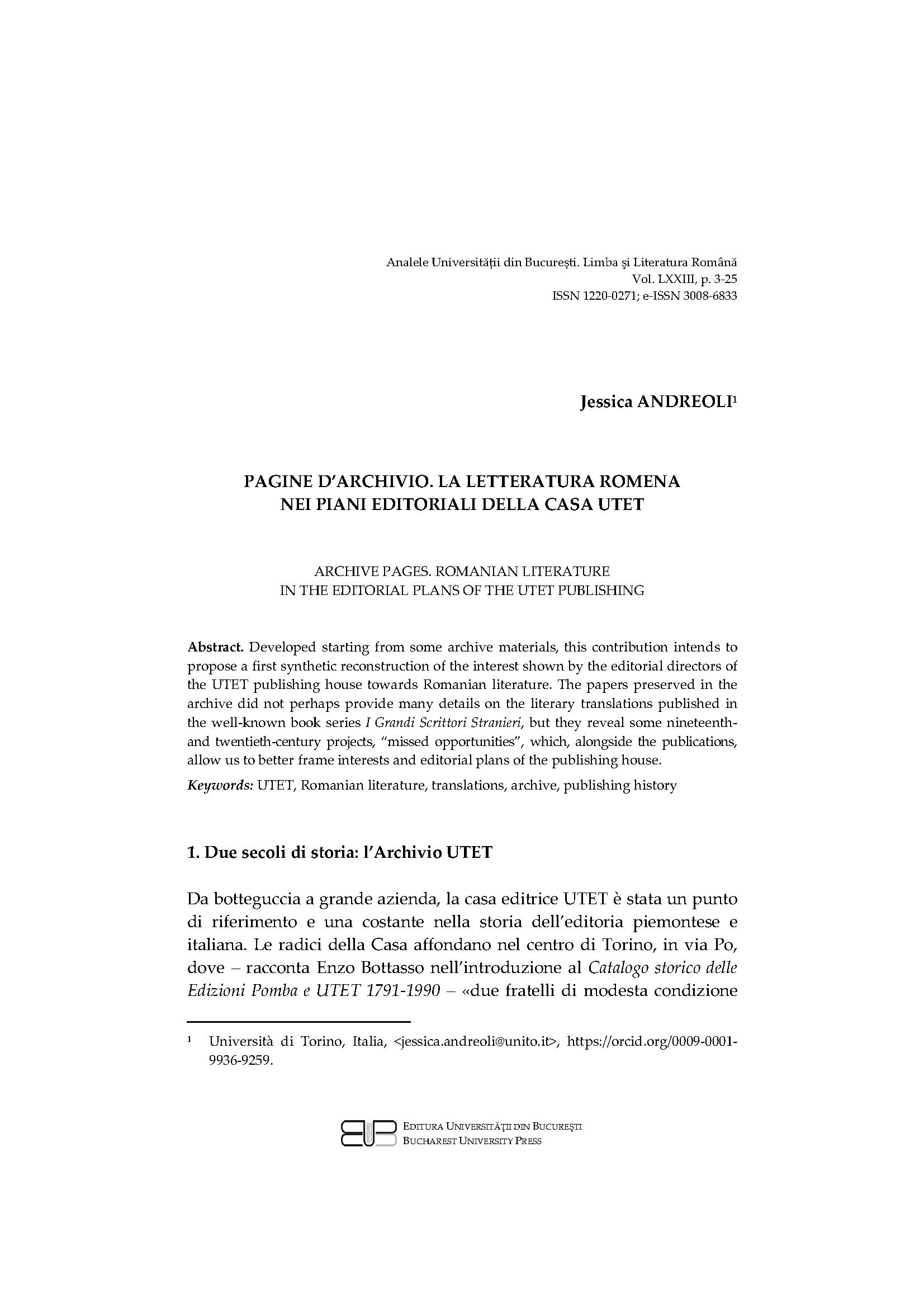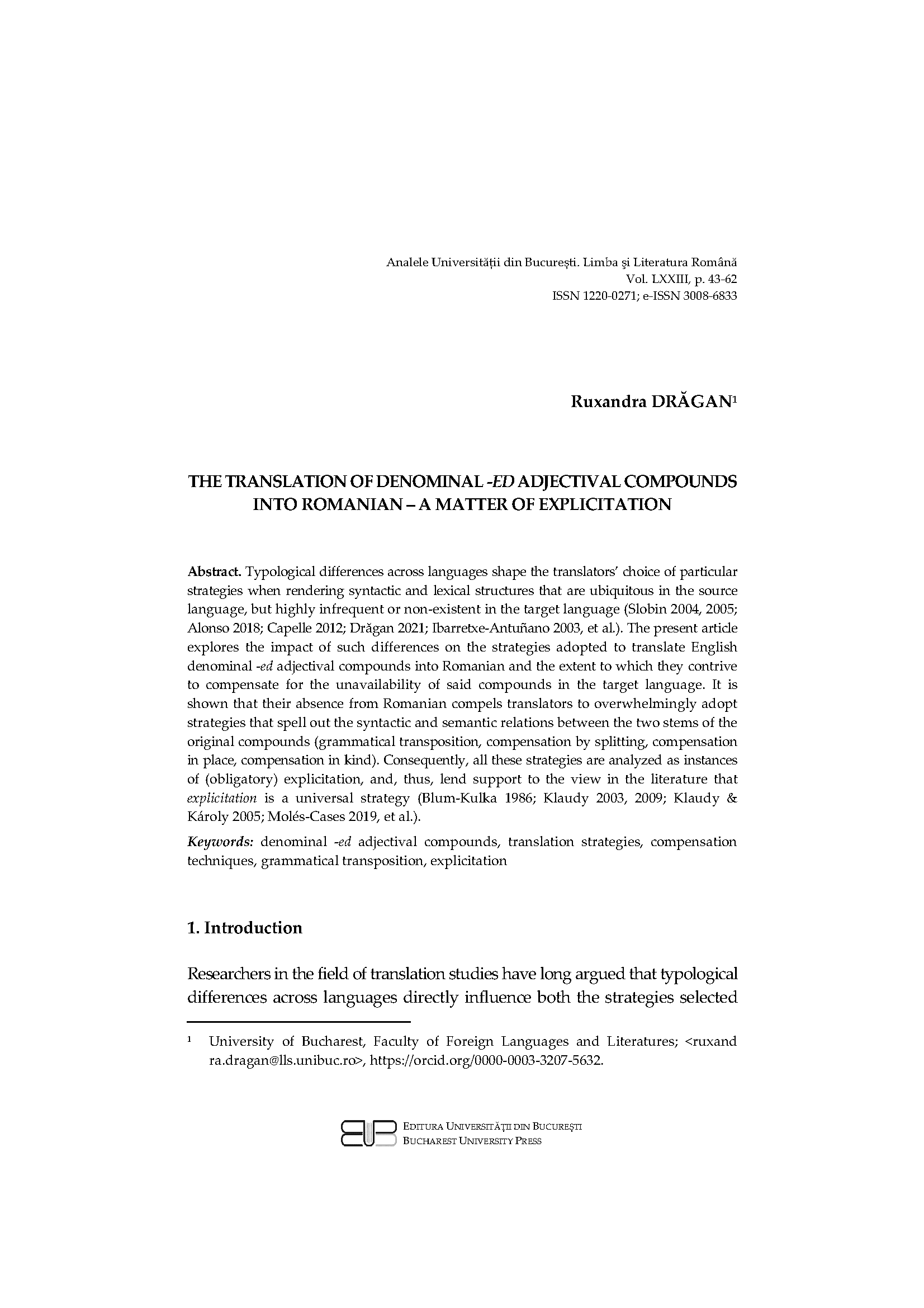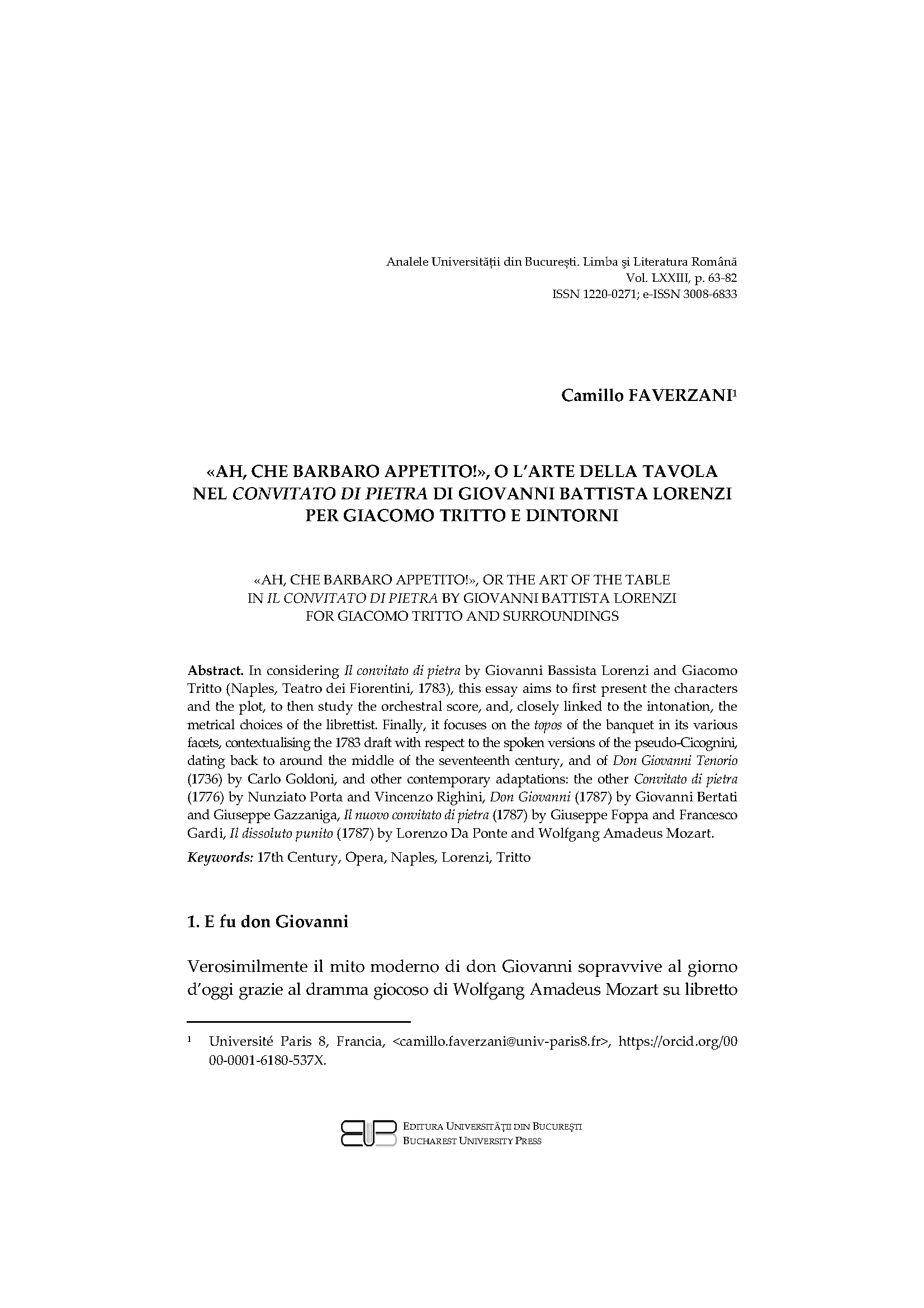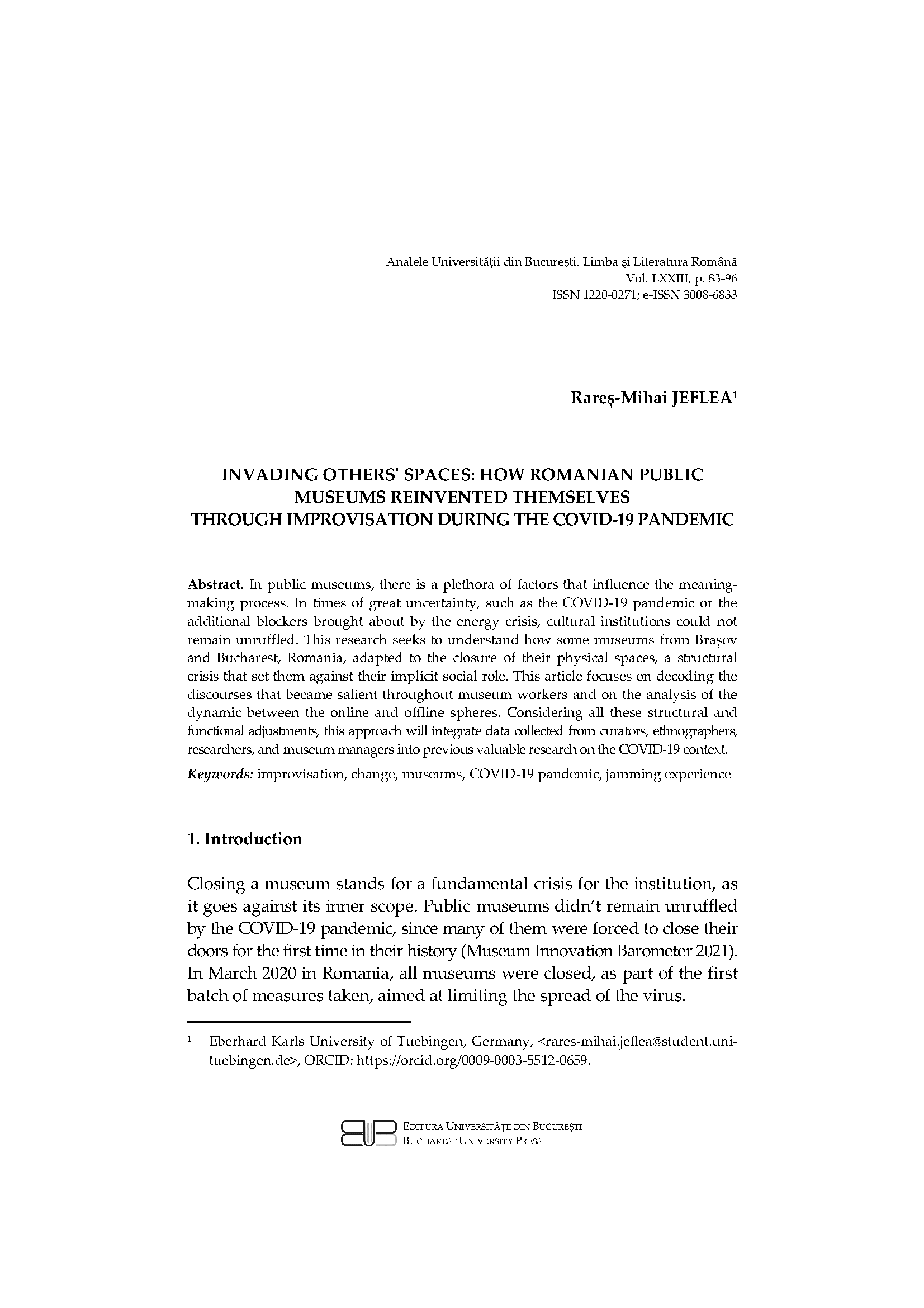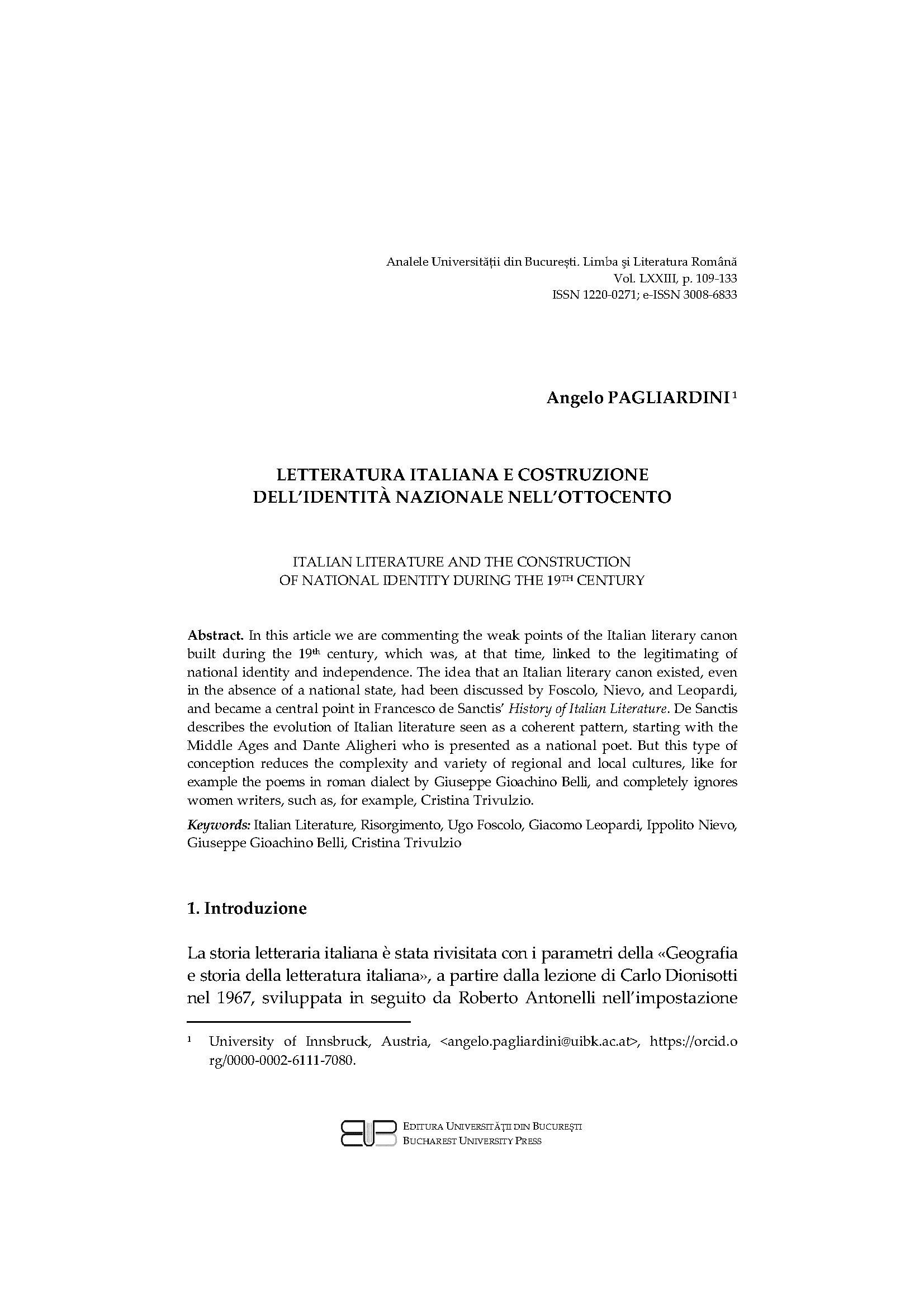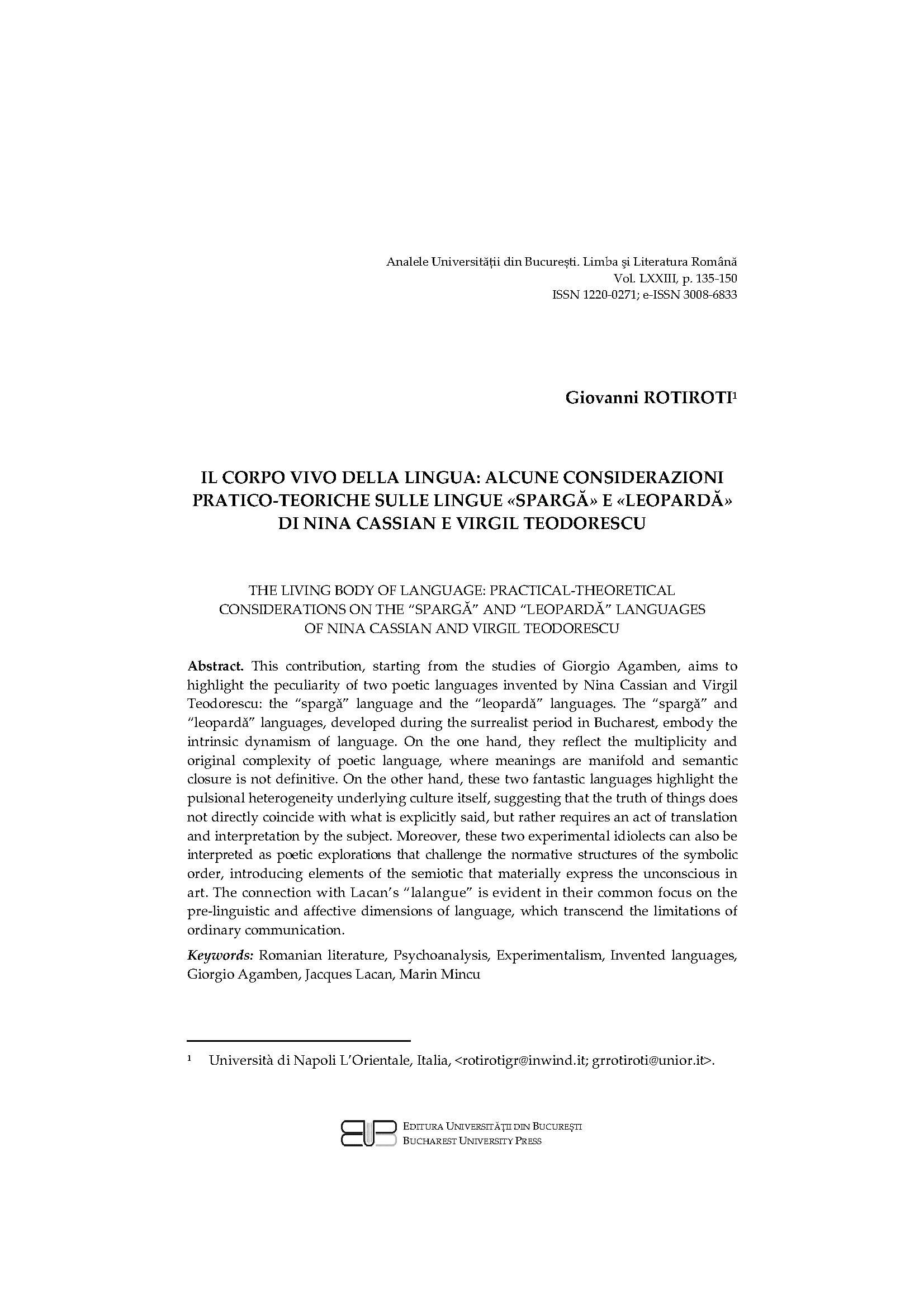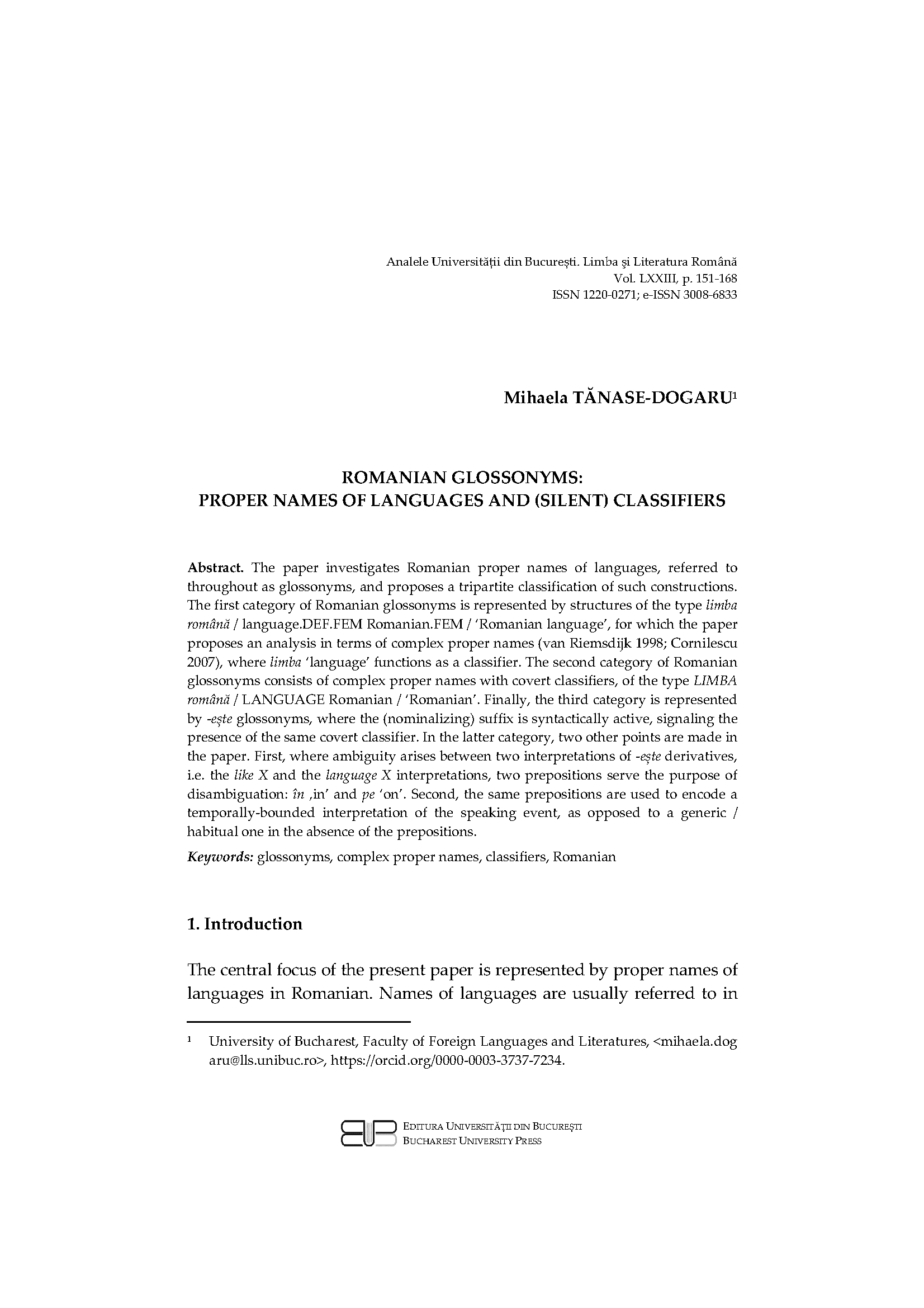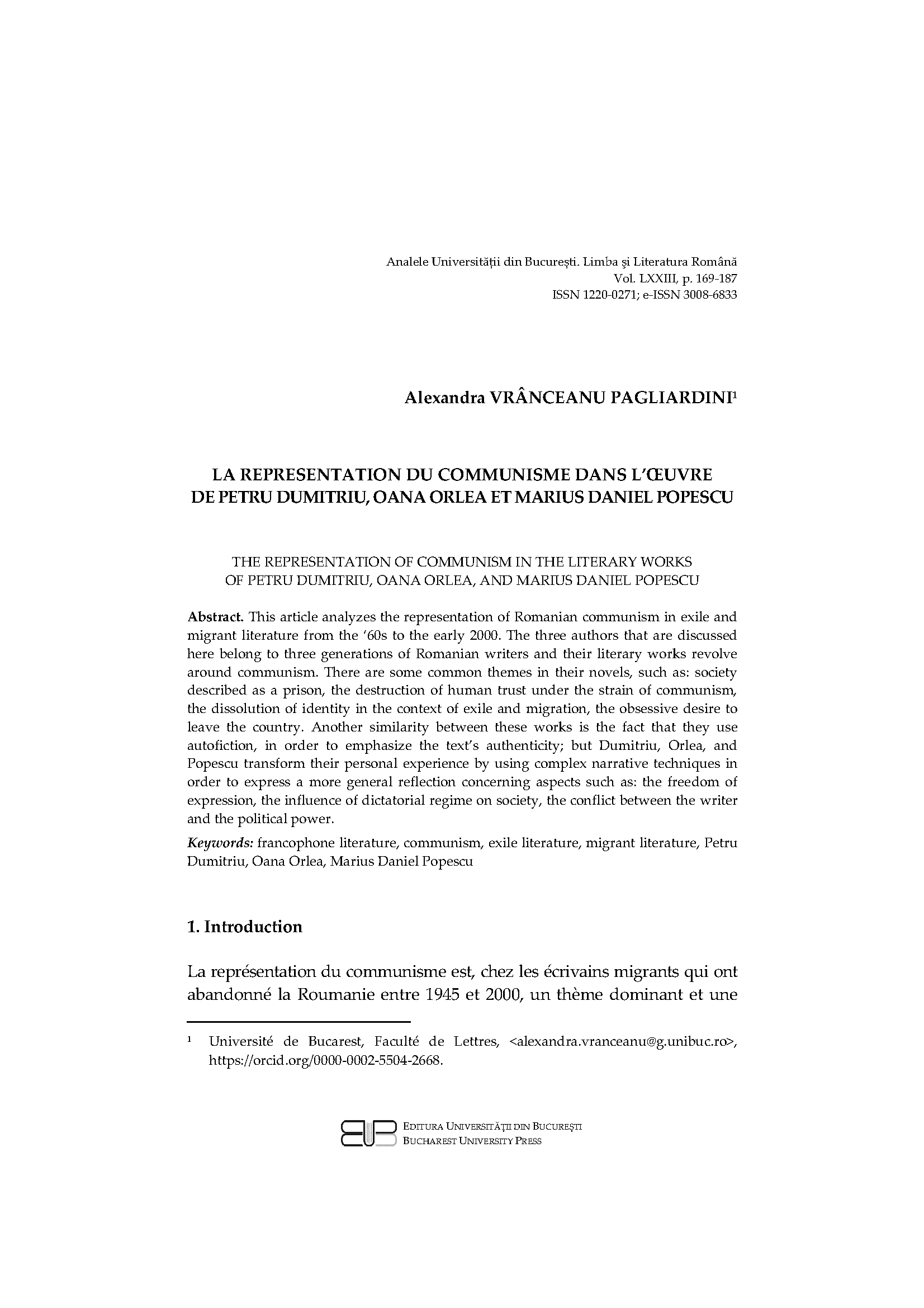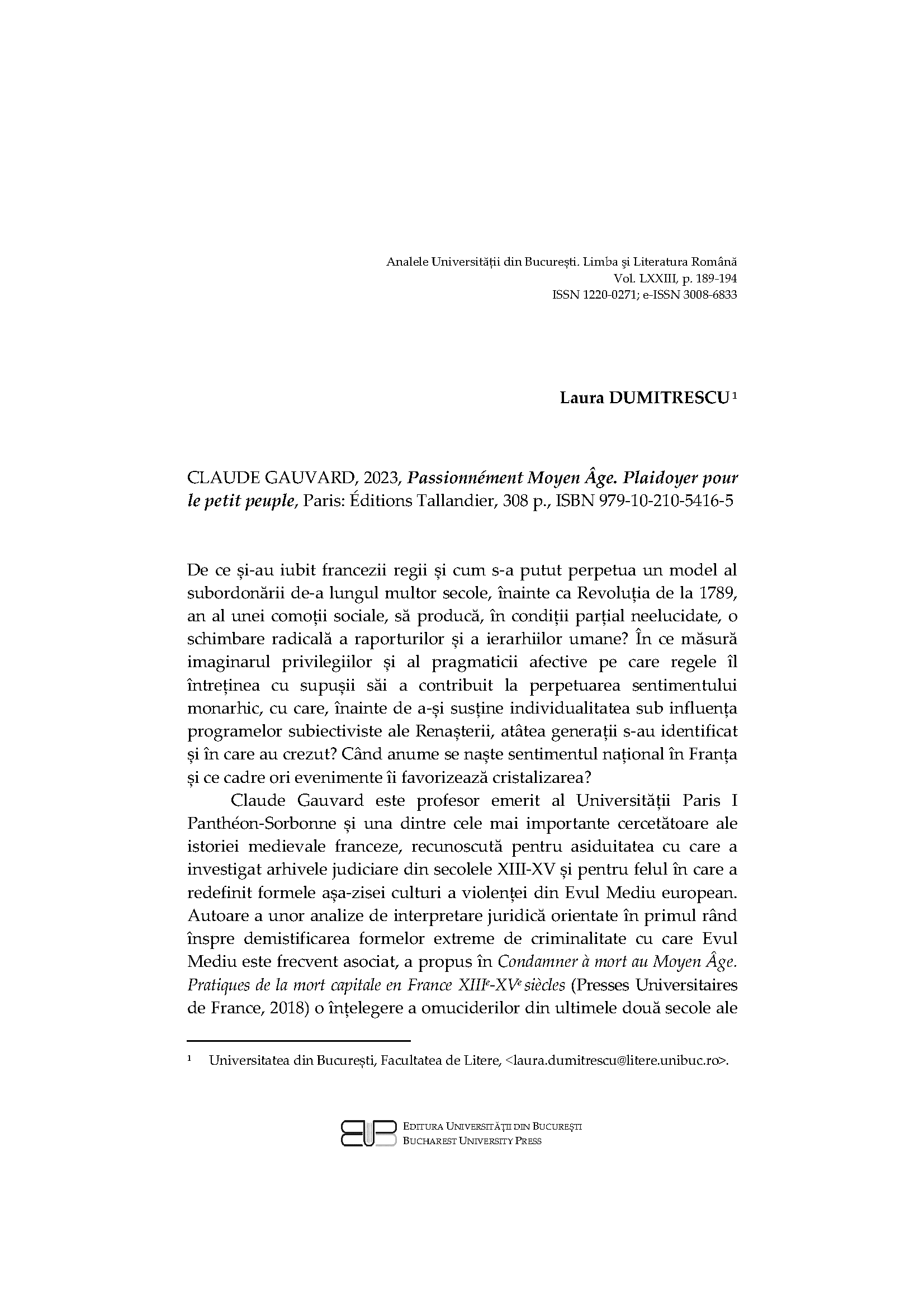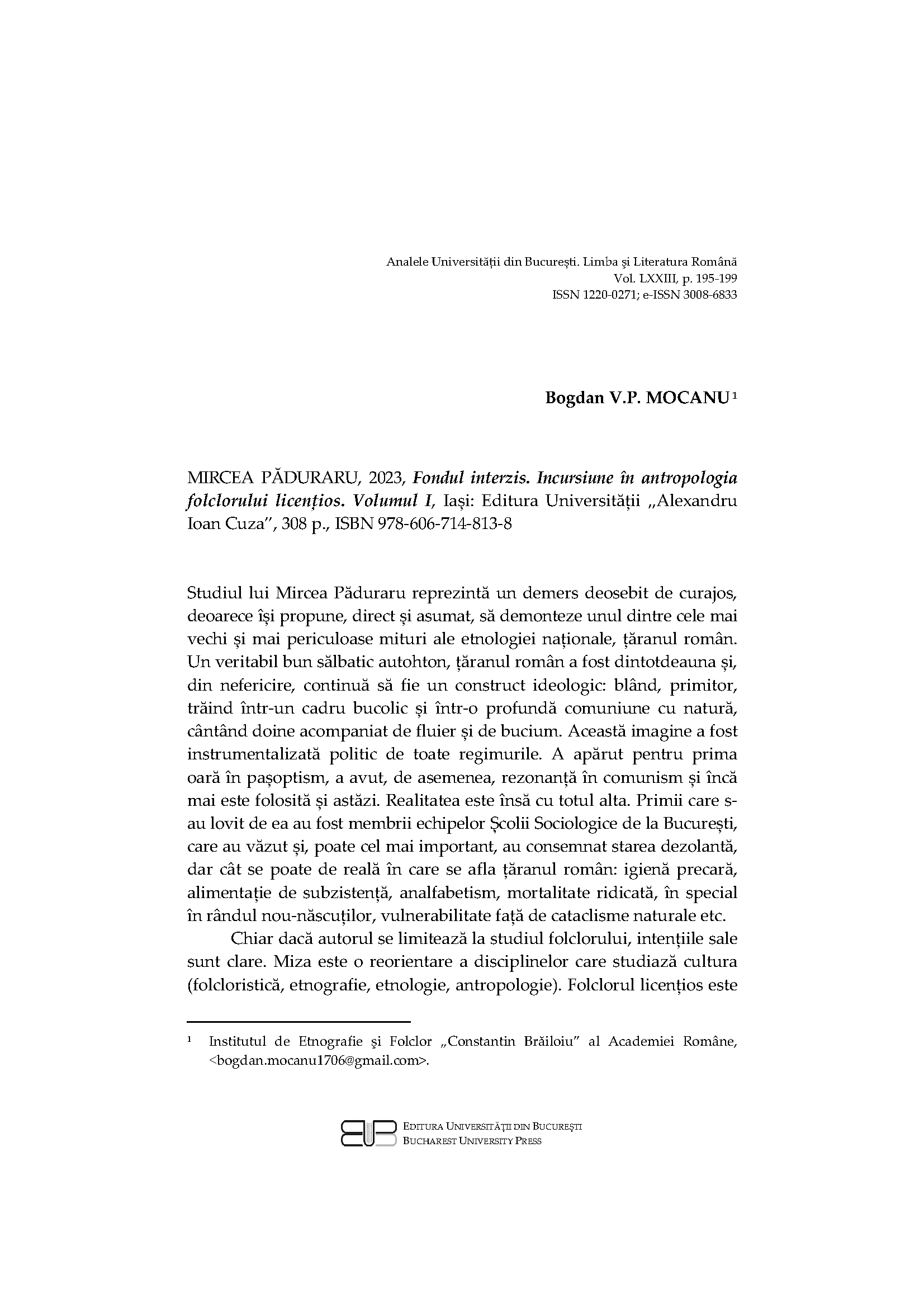Despre revistă
Cu o lungă tradiţie, revista Analele Universităţii Bucureşti. Limba şi literatura română publică articole şi recenzii care tratează teme de interes filologic din diverse domenii conexe: lingvistică privind româna și/sau alte limbi; literatură română; literatură universală şi comparată; teoria literaturii; folclor românesc şi comparat; antropologie culturală. Sunt încurajate, deopotrivă, cercetările din perspectivă pluri- și interdisciplinară, care plasează limba, literatura și cultura română într-un cadru de analiză extins, în acord cu dinamica cercetării științifice actuale din plan internațional.
Revista apare anual, în ediție tipărită și în variantă electronică; revista este disponibilă integral în format online, pe pagina web: http://anale.litere.ro/index.html, fără taxe de utilizare.
Revista este indexată în baze de date internaționale (Erih Plus, Ebsco, CEEOL etc.) și acreditată CNCS (categoria B).
Număr curent
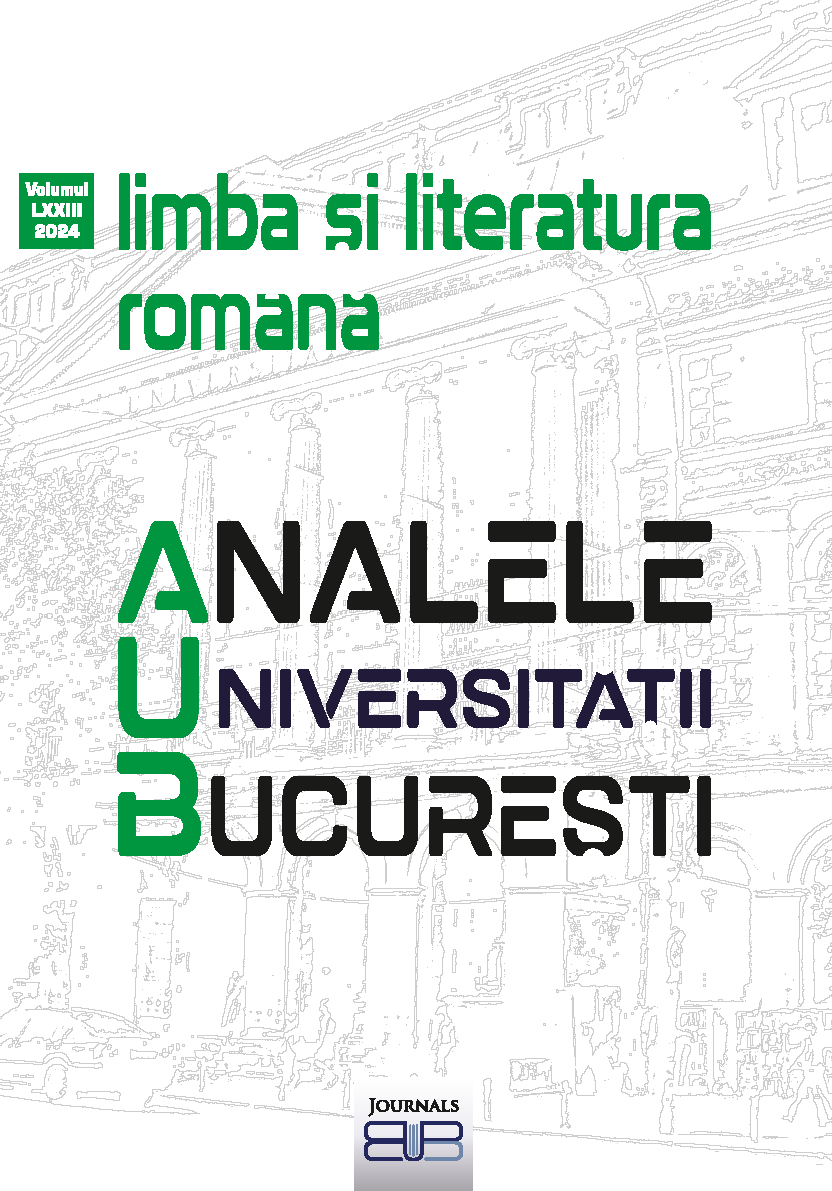
Revista publică articole şi recenzii care tratează teme de interes filologic din diverse domenii conexe: lingvistică privind româna și/sau alte limbi; literatură română; literatură universală şi comparată; teoria literaturii; folclor românesc şi comparat; antropologie culturală.
Număr complet
Articles
-
PAGINE D’ARCHIVIO. LA LETTERATURA ROMENA NEI PIANI EDITORIALI DELLA CASA UTET
Rezumat
Developed starting from some archive materials, this contribution intends to propose a first synthetic reconstruction of the interest shown by the editorial directors of the UTET publishing house towards Romanian literature. The papers preserved in the archive did not perhaps provide many details on the literary translations published in the well-known book series I Grandi Scrittori Stranieri, but they reveal some nineteenthand twentieth-century projects, “missed opportunities”, which, alongside the publications, allow us to better frame interests and editorial plans of the publishing house.
-
"SOLENOID" AS WORLD LITERATURE
Rezumat
This study proposes an analysis of the novel Solenoid from the point of view of world literature theories. The aim of the article is to demonstrate how this contemporary type of discourse contributes to a revaluation of Cărtărescu’s writing in the national sphere, where world literature theories have not been widely explored yet and where Cărtărescu’s novels have sometimes received divergent opinions. First, we will situate our discourse in the context of world literature current debates. Second, Cărtărescu’s novel will be placed in a network of world writers we consider he belongs to. The third part is dedicated to the way in which the image of Bucharest is constructed in the novel. The closing section will clarify the reasons why Cărtărescu’s novel sets into motion but, at the same time, challenges world literature’s network of writers that it establishes strong connections with.
-
THE TRANSLATION OF DENOMINAL "-ED" ADJECTIVAL COMPOUNDS INTO ROMANIAN – A MATTER OF EXPLICITATION
Rezumat
Typological differences across languages shape the translators’ choice of particular strategies when rendering syntactic and lexical structures that are ubiquitous in the source language, but highly infrequent or non-existent in the target language (Slobin 2004, 2005; Alonso 2018; Capelle 2012; Drăgan 2021; Ibarretxe-Antuñano 2003, et al.). The present article explores the impact of such differences on the strategies adopted to translate English denominal -ed adjectival compounds into Romanian and the extent to which they contrive to compensate for the unavailability of said compounds in the target language. It is shown that their absence from Romanian compels translators to overwhelmingly adopt strategies that spell out the syntactic and semantic relations between the two stems of the original compounds (grammatical transposition, compensation by splitting, compensation in place, compensation in kind). Consequently, all these strategies are analyzed as instances of (obligatory) explicitation, and, thus, lend support to the view in the literature that explicitation is a universal strategy (Blum-Kulka 1986; Klaudy 2003, 2009; Klaudy & Károly 2005; Molés-Cases 2019, et al.).
-
«AH, CHE BARBARO APPETITO!», O L’ARTE DELLA TAVOLA NEL CONVITATO DI PIETRA DI GIOVANNI BATTISTA LORENZI PER GIACOMO TRITTO E DINTORNI
Rezumat
In considering Il convitato di pietra by Giovanni Bassista Lorenzi and Giacomo Tritto (Naples, Teatro dei Fiorentini, 1783), this essay aims to first present the characters and the plot, to then study the orchestral score, and, closely linked to the intonation, the metrical choices of the librettist. Finally, it focuses on the topos of the banquet in its various facets, contextualising the 1783 draft with respect to the spoken versions of the pseudo-Cicognini, dating back to around the middle of the seventeenth century, and of Don Giovanni Tenorio (1736) by Carlo Goldoni, and other contemporary adaptations: the other Convitato di pietra (1776) by Nunziato Porta and Vincenzo Righini, Don Giovanni (1787) by Giovanni Bertati and Giuseppe Gazzaniga, Il nuovo convitato di pietra (1787) by Giuseppe Foppa and Francesco Gardi, Il dissoluto punito (1787) by Lorenzo Da Ponte and Wolfgang Amadeus Mozart.
-
INVADING OTHERS' SPACES: HOW ROMANIAN PUBLIC MUSEUMS REINVENTED THEMSELVES THROUGH IMPROVISATION DURING THE COVID-19 PANDEMIC
Rezumat
In public museums, there is a plethora of factors that influence the meaningmaking process. In times of great uncertainty, such as the COVID-19 pandemic or the additional blockers brought about by the energy crisis, cultural institutions could not remain unruffled. This research seeks to understand how some museums from Brașov and Bucharest, Romania, adapted to the closure of their physical spaces, a structural crisis that set them against their implicit social role. This article focuses on decoding the discourses that became salient throughout museum workers and on the analysis of the dynamic between the online and offline spheres. Considering all these structural and functional adjustments, this approach will integrate data collected from curators, ethnographers, researchers, and museum managers into previous valuable research on the COVID-19 context.
-
DESTINERRANCE. O EXPERIENŢĂ VIZUALĂ A TRAVERSĂRII EUROPEI ÎN ELEGIA UNEI CĂLĂTORII DE ALEXANDR SOKUROV
Rezumat
Starting from an analysis of Alexandr Sokurov’s documentary essay Elegy of a Voyage, this article proposes an examination of the experience of travel, of space-crossing, through the lens of a term that Jacques Derrida coined to define the ”postal principle”:
destinerrance. Beyond merely testing the operational value of Derrida’s term, the analysis here aims to explore the formulas and the strategies Sokurov mobilizes to articulate visually the relationship between the ”suffering of the destination” (a journey across
Europe from St. Petersburg to the Boijmans van Beuningen Museum in Rotterdam, in a difficult natural and cultural context) and its aesthetic expression (the nostalgia for a classical Europe that only survives in art). -
LETTERATURA ITALIANA E COSTRUZIONE DELL’IDENTITÀ NAZIONALE NELL’OTTOCENTO
Rezumat
In this article we are commenting the weak points of the Italian literary canon built during the 19th century, which was, at that time, linked to the legitimating of national identity and independence. The idea that an Italian literary canon existed, even in the absence of a national state, had been discussed by Foscolo, Nievo, and Leopardi, and became a central point in Francesco de Sanctis’ History of Italian Literature. De Sanctis describes the evolution of Italian literature seen as a coherent pattern, starting with the Middle Ages and Dante Aligheri who is presented as a national poet. But this type of conception reduces the complexity and variety of regional and local cultures, like for example the poems in roman dialect by Giuseppe Gioachino Belli, and completely ignores women writers, such as, for example, Cristina Trivulzio.
-
IL CORPO VIVO DELLA LINGUA: ALCUNE CONSIDERAZIONI PRATICO-TEORICHE SULLE LINGUE «SPARGĂ» E «LEOPARDĂ» DI NINA CASSIAN E VIRGIL TEODORESCU
Rezumat
This contribution, starting from the studies of Giorgio Agamben, aims to highlight the peculiarity of two poetic languages invented by Nina Cassian and Virgil Teodorescu: the “spargă” language and the “leopardă” languages. The “spargă” and “leopardă” languages, developed during the surrealist period in Bucharest, embody the intrinsic dynamism of language. On the one hand, they reflect the multiplicity and original complexity of poetic language, where meanings are manifold and semantic closure is not definitive. On the other hand, these two fantastic languages highlight the pulsional heterogeneity underlying culture itself, suggesting that the truth of things does not directly coincide with what is explicitly said, but rather requires an act of translation
and interpretation by the subject. Moreover, these two experimental idiolects can also be interpreted as poetic explorations that challenge the normative structures of the symbolic order, introducing elements of the semiotic that materially express the unconscious in art. The connection with Lacan’s “lalangue” is evident in their common focus on the pre-linguistic and affective dimensions of language, which transcend the limitations of ordinary communication. -
ROMANIAN GLOSSONYMS: PROPER NAMES OF LANGUAGES AND (SILENT) CLASSIFIERS
Rezumat
The paper investigates Romanian proper names of languages, referred to throughout as glossonyms, and proposes a tripartite classification of such constructions. The first category of Romanian glossonyms is represented by structures of the type limba
română / language.DEF.FEM Romanian.FEM / ‘Romanian language’, for which the paper proposes an analysis in terms of complex proper names (van Riemsdijk 1998; Cornilescu 2007), where limba ‘language’ functions as a classifier. The second category of Romanian glossonyms consists of complex proper names with covert classifiers, of the type LIMBA română / LANGUAGE Romanian / ‘Romanian’. Finally, the third category is represented by -ește glossonyms, where the (nominalizing) suffix is syntactically active, signaling the presence of the same covert classifier. In the latter category, two other points are made in the paper. First, where ambiguity arises between two interpretations of -ește derivatives, i.e. the like X and the language X interpretations, two prepositions serve the purpose of disambiguation: în ‚in’ and pe ‘on’. Second, the same prepositions are used to encode a temporally-bounded interpretation of the speaking event, as opposed to a generic / habitual one in the absence of the prepositions. -
LA REPRESENTATION DU COMMUNISME DANS L’OEUVRE DE PETRU DUMITRIU, OANA ORLEA ET MARIUS DANIEL POPESCU
Rezumat
This article analyzes the representation of Romanian communism in exile and migrant literature from the ‘60s to the early 2000. The three authors that are discussed here belong to three generations of Romanian writers and their literary works revolve around communism. There are some common themes in their novels, such as: society described as a prison, the destruction of human trust under the strain of communism, the dissolution of identity in the context of exile and migration, the obsessive desire to leave the country. Another similarity between these works is the fact that they use autofiction, in order to emphasize the text’s authenticity; but Dumitriu, Orlea, and Popescu transform their personal experience by using complex narrative techniques in order to express a more general reflection concerning aspects such as: the freedom of expression, the influence of dictatorial regime on society, the conflict between the writer and the political power.
Book Reviews
-
CLAUDE GAUVARD, 2023, Passionnément Moyen Âge. Plaidoyer pour le petit peuple Paris: Éditions Tallandier, 308 p., ISBN 979-10-210-5416-5
Rezumat
De ce și-au iubit francezii regii și cum s-a putut perpetua un model al subordonării de-a lungul multor secole, înainte ca Revoluția de la 1789, an al unei comoții sociale, să producă, în condiții parțial neelucidate, o schimbare radicală a raporturilor și a ierarhiilor umane? În ce măsură imaginarul privilegiilor și al pragmaticii afective pe care regele îl întreținea cu supușii săi a contribuit la perpetuarea sentimentului monarhic, cu care, înainte de a-și susține individualitatea sub influența programelor subiectiviste ale Renașterii, atâtea generații s-au identificat și în care au crezut? Când anume se naște sentimentul național în Franța și ce cadre ori evenimente îi favorizează cristalizarea?
-
MIRCEA PĂDURARU, 2023, Fondul interzis. Incursiune în antropologia folclorului licențios. Volumul I Iași: Editura Universității „Alexandru Ioan Cuza”, 308 p., ISBN 978-606-714-813-8
Rezumat
Studiul lui Mircea Păduraru reprezintă un demers deosebit de curajos, deoarece își propune, direct și asumat, să demonteze unul dintre cele mai vechi și mai periculoase mituri ale etnologiei naționale, țăranul român. Un veritabil bun sălbatic autohton, țăranul român a fost dintotdeauna și, din nefericire, continuă să fie un construct ideologic: blând, primitor, trăind într-un cadru bucolic și într-o profundă comuniune cu natură, cântând doine acompaniat de fluier și de bucium. Această imagine a fost instrumentalizată politic de toate regimurile. A apărut pentru prima oară în pașoptism, a avut, de asemenea, rezonanță în comunism și încă mai este folosită și astăzi. Realitatea este însă cu totul alta. Primii care sau lovit de ea au fost membrii echipelor Școlii Sociologice de la București, care au văzut și, poate cel mai important, au consemnat starea dezolantă, dar cât se poate de reală în care se afla țăranul român: igienă precară, alimentație de subzistență, analfabetism, mortalitate ridicată, în special în rândul nou-născuților, vulnerabilitate față de cataclisme naturale etc.

